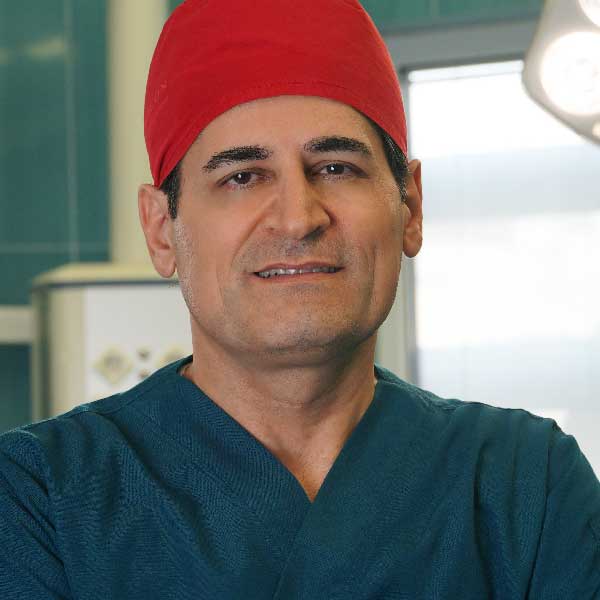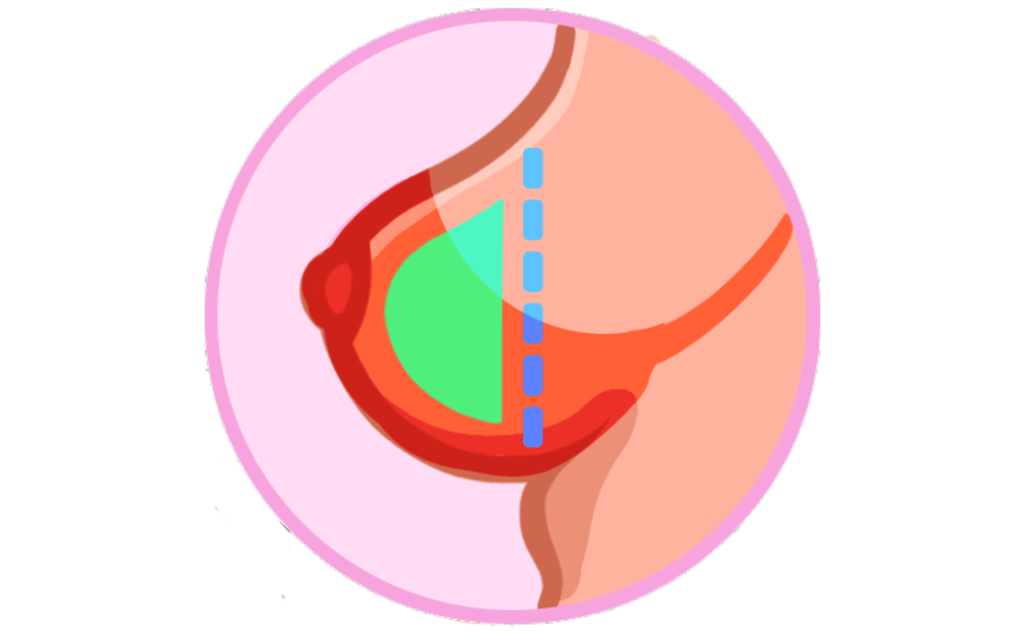
Breast augmentation
Having beautiful and shapely breasts brings high self-confidence to many women. There are several reasons for a woman to perform breast prosthesis surgery. In addition to helping to create fitness, breast augmentation can also be suitable in compensating for lost breast volume after pregnancy and breastfeeding. Also, this procedure can be used in cases where there is a mismatch between the sizes of the breasts.
Silicone prostheses are the most common prostheses used in breast prosthesis surgery, which have been produced in five different generations and are available in round and teardrop (anatomical) shapes and in different sizes and volumes.
In the following article, in order to know more about beautiful women, we will give brief explanations about breast prosthesis.
History
The modern artificial breast was invented in 1961 by American plastic surgeons Thomas Cronin and Frank Grove and was manufactured by Dow Corning.
Saline-filled breast implants were first developed by Arion company in France and introduced in 1964 for use as an artificial medical device.
Each generation of breast prosthesis is defined by common modeling techniques
Since the invention and manufacture of breast prosthesis until today, five generations of breast prosthesis have been produced and put on the market.
Introduction of breast prosthesis generations
first generation
The Cronin-Gerow implant, a 1963 prosthesis model, was a teardrop-shaped silicone rubber envelope bag filled with viscous silicone gel.
second generation
In the 1970s, manufacturers introduced second-generation breast implant prostheses. Second-generation breast implants were fragile and had a higher rate of shell rupture and silicone gel leakage.
Third and fourth generation
In the 1980s, third- and fourth-generation implants were produced and staged advances in manufacturing technology. This generation of implants had elastomer-coated shells that reduced the leakage of the silicone gel and had a thicker, more adherent filling gel.
Then, manufacturers of breast prostheses designed and marketed anatomical models (such as natural breasts) and models that realistically matched the breasts and body shape of real women.
The fifth generation
Since the mid-1990s, the fifth generation of silicone gel breast implants have been made of a semi-solid gel that largely eliminates silicone gel leakage and displacement from the implant.
Introduction of breast implant
Having beautiful and shapely breasts brings high self-confidence to many women. There are several reasons for a woman to perform breast prosthesis surgery. In addition to helping to create fitness, breast implant can also be suitable in compensating for lost breast volume after pregnancy and breastfeeding. Also, this procedure can be used in cases where there is a mismatch between the sizes of the breasts.
Breast prosthesis or breast augmentation is one of the common and popular procedures and surgeries among women, which is performed by a plastic surgeon and a breast prosthesis specialist to beautify people’s breasts.
Breast augmentation is done by placing silicone gel or saline gel or injecting fat tissue in the breast area by a plastic and aesthetic surgeon, which of course has different results in each of the methods.
This type of surgery is an outpatient procedure and usually does not require an overnight stay in a clinic or hospital.
Survey of breast implant beauticians reported about their mental health and quality of life, improved physical health, physical appearance, social life, self-confidence, self-esteem and satisfactory sexual performance. In addition, the majority of women reported long-term satisfaction with their breast implant.

Reasons for using breast prosthesis
- A beautiful and more suitable form of the breast with the purpose of beauty
- insufficient growth of breast tissue during puberty
- Reduction of interstitial breast tissue following weight loss
- Congenital anomalies of one or two sides of the breast
- Sagging and reduction of breast volume after breastfeeding
- Mastectomy following breast cancer
Based on the physical examination of the breast tissue and the client’s request, breast prostheses can be used in different sizes and forms.
Advantages and characteristics of breast prosthesis
Breast prostheses are mainly made of soft silicone gel enclosed in a thin layer. They are made to resemble the natural shape of women’s breasts or part of their breasts. The outer surface appears smooth and may include an outline of a nipple.
Cases of women who have undergone surgery for breast cancer and for which no reconstruction has been done use a prosthesis, and also for people whose breast shape and size are not similar on both sides, it can be helpful.
This method is a very suitable option for people who want to enlarge their breasts in order to beautify and shape them.
Another important point of the prostheses is that there are no problems during breastfeeding and pregnancy.
How to determine the size of the prosthesis
In the face-to-face consultation session, after the initial history, the doctor will examine the breast tissue, breast volume, skin stretch and examine your chest wall, then he will choose the most suitable prosthesis in terms of model, size and prominence for you in the traditional method. If your chest is not wide and you are thin, a prosthesis with a very large size is not recommended because your body will take an unnatural shape.
Fortunately, due great interest of Dr. Gholamhossein Ghorabi in using modern technologies for better accuracy and easier selection of the type and form of prosthesis, you will see the use of the 3D breast and body scanning system (Crisalix 3D) and the simulation of the breast and chest in the computer.
Types of breast prostheses
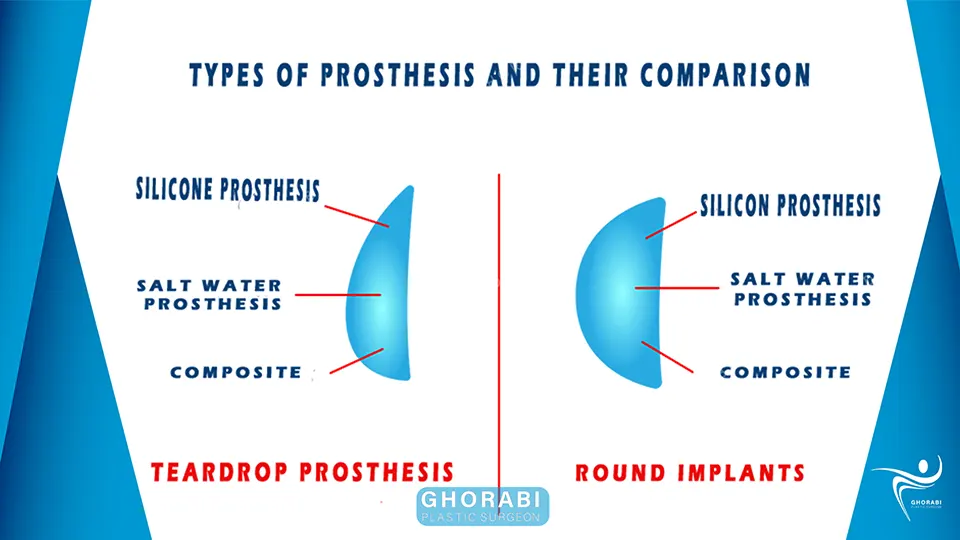
types of breast implants in terms of ingredients
So far, four types of implants (prostheses) have been produced and put on the market.
- Salt water prostheses, as the name suggests, are filled with sterile saline solution.
- Silicone prostheses, as the name suggests, are filled with viscous silicone gel.
- “Structured” prostheses use nested elastomeric silicone shells that are filled with sterile saline between the shells.
- Prostheses with alternative composition, filled with different fillers such as soya bean oil or polypropylene filament (no longer produced)
Types of breast prostheses in terms of prominence and diameter
Prostheses are divided into four groups according to the amount of prominence:
- Low profile breast prosthesis
- Mid profile breast prosthesis
- High profile breast prosthesis
- Ultra-high profile breast prosthesis
- Ultra-high profile breast prosthesis
Types of breast prostheses in terms of appearance based on observation
The types of breast prostheses are different based on their appearance and they are produced in several forms, which the subspecialist doctor decides to use based on the anatomy of each person.
- Round prostheses
Some types of prostheses are round and in the profile of these types of prostheses, their upper and lower parts are the same when viewed, so these types of prostheses are called round implants. - Teardrop prostheses
Another type of prostheses looks more empty in its upper part compared to the lower half, so this type of implant is called teardrop or anatomical prosthesis. - Left spherical prosthesis
Another type of prosthesis is the left spherical model. Its design is such that the amount of gel in the left half of the prosthesis is more than its right half. - Prosthetic model of the center shape
Another type of prosthesis is the center shape model, its design is such that the amount of gel in the center of the implant is more than the right and left sides. - Right spherical prosthesis
Another type of prostheses is the right spherical model, its design is such that the amount of gel in the right half is more than the left half.
The last three models are the latest generation of silicone gel breast implants that are specifically used in breast abnormalities.
Breast prosthesis operation
How is the breast prosthesis operation done?
The first step during cosmetic breast surgery is a consultation and visit with an experienced plastic surgeon and a clarification of the level of expectations after the operation, as well as performing tests related to physical health.
Like as some others cosmetic surgery, this operation is possible on an outpatient basis with general anesthesia and in the following three ways, depending on the surgeon’s opinion and the applicant’s conditions.
- Surgery through the area under the breast line
- Surgery through the area of the areola of the nipple
- Surgery through the armpit
Each of the methods has its own advantages, and in general, it can be said that the advantage of the under-breast incision method is the ease of placement of the prosthesis by the surgeon is under chest muscle, and the incision site will be less visible.
IN the case of cutting around the areola, we can also mention the advantage of symmetry between the breasts, which of course is not recommended for people who intend to breastfeed in the future.
And the advantage of the armpit method is that there is no obvious scar.
After determining and choosing the type of surgical procedure, the type of prosthesis or silicone is selected according to the anatomy and the desire of the beautician.
After determining the day of surgery and admission to the desired surgery center, breast prosthesis surgery is performed under general anesthesia.
It can also be said that the duration of the operation is between 1 and 2 hours and there is no need to stay in the hospital for night.
Breast prosthesis insertion sites
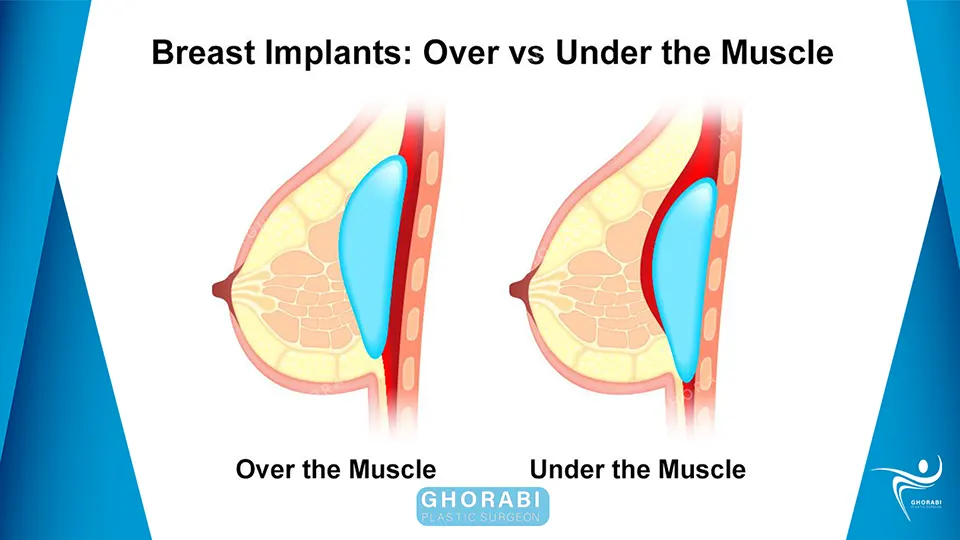
- Subpectoral” in this method is the best way to show the breasts and the incidence of capsular contraction is reduced.
- Sub glandular” in this method, the prosthesis is placed under the gland, which brings less pain and more attractiveness to the breast, but its disadvantages will be more than its advantages.
- Subfascial” This method is suggested by some surgeons and its causes can be mentioned such as less pain, lower capsule contraction.
- Dual plan, as the name suggests, the prosthesis is placed in two areas under the gland and under the muscle, and the maximum coverage is placed for the prosthesis and many complications are avoided.
One of the common questions regarding the location of the breast implant is whether the prosthesis is placed on the muscle or under the muscle?
What is the basis for choosing the surface of breast prosthesis?
The surface of the prosthesis can be rough, which is called texture in medical terms.
There is a type of prosthesis surface that has a completely smooth and polished surface, which is called smooth in medical terms.
In the vast majority of people, both types of texture and smooth prostheses can be used, and the choice of each of these types of prostheses depends on the discretion of the plastic and cosmetic surgery specialist and in some cases based on the patient’s opinion.
What are the types of breast prosthesis incision?

Breast implant implantation can be done with five surgical incision methods:
- Incision through the inframammary fold
The incision made under the breast provides maximum access for breast implant placement. This is the preferred surgical method for placing silicone gel implants, as longer incisions are required. However, sub mammary incisions can create thicker and slightly more visible surgical scars. - Cut around the breast halo
An incision made along the perimeter of the areola with the border of the skin around it, this incision is the ideal approach when it is necessary to adjust the position of the areola, or when mastopexy (breast lift) is performed simultaneously and initially with breast prosthesis. It presents to the rest of the cuts. In the peri-areola method, the incision is around the lower half of the areola circumference. Placement of silicone gel implants in beauties with small areola diameters may be difficult with this incision, as at least five centimeters of access incision is required.In terms of aesthetics, since the scars are located on the border of the areola, they are usually less visible than the scars of the incision under the breast in women with areolas with light pigmentation. - Trans axillary incisio
In this surgical technique, a small incision is made in the armpit, from which the tunnel is extended to the center using a video endoscope system, thus allowing the implants to be placed on the breast without creating visible scars. But there is a possibility of creating asymmetry in the line under the breast in the position of the implant. - Transabdominal incision
In trans abdominoplasty (TABA) breast augmentation, while the patient undergoes breast prosthesis and abdominoplasty surgery at the same time, the breast prosthesis is implanted from the abdominal abdominoplasty incision site in the tunnels created by the breast prosthesis. - Cutting around the navel
In this method, by making a small incision in the upper part of the navel and using an endoscopic system, the necessary tunnel is created and the implant is placed in the breast. Obviously, in this method, only salt water prostheses can be used, and silicone implants cannot be implanted with an incision around the navel.
Placement of breast prosthesis
There are common questions about the placement of breast implants
Should the prosthesis be placed under the chest muscle or on the muscle?
Which one is best and has better results?
In fact, the location of the breast prosthesis is different and depending on the physical condition of the beauty.
In people who are thin and have little subcutaneous fat, the surgeon usually decides to use the submuscular layer for implanting the prosthesis because this layer causes the breast prosthesis to be well protected and the edge of the prosthesis cannot be seen or touched.
In people who have an ideal weight and have suitable breast tissue, the prosthesis can be placed on the breast muscle
differences in the location of the breast prosthesis
There are four surgical methods for placing a breast prosthesis in the implant tunnel in relation to the pectoralis major muscle, each with its own advantages and disadvantages.
- Under the mammary gland
the breast implant is placed in the space behind the mammary, between the breast tissue (mammary gland) and the pectoralis major muscle (the main muscle of the chest), which is closer to the surface of the natural breast tissue and gives the most aesthetic results. However, in women with thin breast soft tissue, the sub glandular position is more likely to have waves and foldsand shows the wrinkles of the underlying implant. In addition, the incidence of capsular contracture is slightly higher with sub glandular implantation. - Subfascial
The subfascial position is a variant of the sub glandular position for breast implants. The breast prosthesis is placed under the pectoralis major muscle fascia. The technical advantages of the subfascial implant procedure are discussed. Those who agree report that the fascial tissue layer provides more coverage for the implant and maintains its position better. - Subpectoral (dual level)
The breast implant is placed under the pectoralis major muscle after the surgeon has released the underlying muscle attachments with or without a partial sub glandular surface incision. As a result, the upper half of the implant is partially below the pectoralis major muscle, while the lower half of the implant is at the sub glandular level. This method of implantation achieves maximum coverage of the upper half of the implant, while allowing for expansion of the lower half of the implant. However, the movement of the implant at the sub-breast level can be too much for some patients - Submuscular
The breast implant is placed under the pectoralis major muscle, without exposing the lower origin of the muscle. Complete muscle coverage of the implant can be achieved by releasing the lateral muscles of the chest wall, either the serratus muscle or the pectoralis minor muscle or both, and suturing it or them to the pectoralis major muscle. In breast reconstruction surgery after cancer, the submuscular implantation method has a beneficial effect on the maximum coverage of the breast prosthesis.
Correcting breast sagging asymmetry with prosthesis
Breasts that have fallen due to pregnancy and weight loss can be corrected by breast lift or mastopexy. Breast lift has different methods, based on the amount of sagging and the skill of the surgeon in the chosen technique, each of them has a high success rate.
If a person’s breasts are not symmetrical, there are several ways to fix the lack of symmetry. If the tissue of one of the breasts is large, in such cases, the tissue of the breast with the larger tissue is removed for matching the breasts.
Breasts that have fallen due to pregnancy and weight loss can be corrected by breast lift or mastopexy. Breast lift has different methods, based on the amount of sagging and the skill of the surgeon in the chosen technique, each of them has a high success rate.
If a person’s breasts are not symmetrical, there are several ways to fix the lack of symmetry. If the tissue of one of the breasts is large, in such cases, the tissue of the breast with the larger tissue is removed for matching the breasts.
Details of the breast prosthesis surgery
The plastic surgeon considers the breast tissue in terms of shape, size and quality of the skin, the thickness of the existing breast tissue, as well as taking into account the patient’s desired goal and result, the best and most appropriate technique and type of prosthesis. Sometimes we need a combination of methods, which means by creating a cut in the brown halo of the breast, and may need combined mastopexy with prosthesis.
The process of breast prosthesis surgery on the day of surgery is that after determining the type and size of the prosthesis, the exact location of the prosthesis is marked.
The induction of general anesthesia is done by the anesthesiologist and his assistant.
Your chest and breasts are disinfected with special materials and the surgical site is covered with special dressings and the surgery begins.
After making a cut, the implant is placed in the desired area. At the end, a 3-4 cm cut is sutured in the desired area.
At the end of the breast prosthesis surgery, a dressing is placed on the suture line. Over time, the incision line will fade.
Breast prosthesis surgery
Preoperational breast prosthesis surgery
Before the breast prosthesis surgery, the plastic surgeon collects information and reviews your medical records during a face-to-face consultation with you.
A complete medical history and history of symptoms of underlying diseases and related problems will be taken in you and your family.
You will be asked about the complete history of possible previous surgeries and the reason for these surgeries.
In women under 40 years of age, breast ultrasound is requested. In women over 40 years old, mammography of the breasts should also be checked.
All clients need to perform laboratory tests based on the doctor’s opinion based on the history and physical examination.
In addition to the above, there are a series of tips and actions that must be followed by you, including:
1)Stop smoking a few weeks before surgery because the risk of complications from surgery is higher in smokers.
2)Discontinuation of anti-inflammatory drugs, anticoagulation drugs, aspirin and aspirin-containing drugs. Because these types of drugs increase the possibility of bleeding.
3)Performing tests prescribed by the doctor.
4)The use of any medication, herbal supplements and vitamins should be reported to the doctor. Sometimes it is necessary to stop the drugs and replace it with a new one.
5)In order to perform breast prosthesis surgery, it is forbidden to eat or drink liquids eight hours before the surgery.
6)Usually, before the start of surgery, the use of intravenous antibiotics is considered to prevent the occurrence of infection.
In the pre-surgery consultation, the doctor will discuss the following:
- Type of prosthesis (silicone or saline gel)
- The size of the prosthesis
- Location of the prosthesis
- Complications during and after surgery
- Surgical technique
Care after breast prosthesis
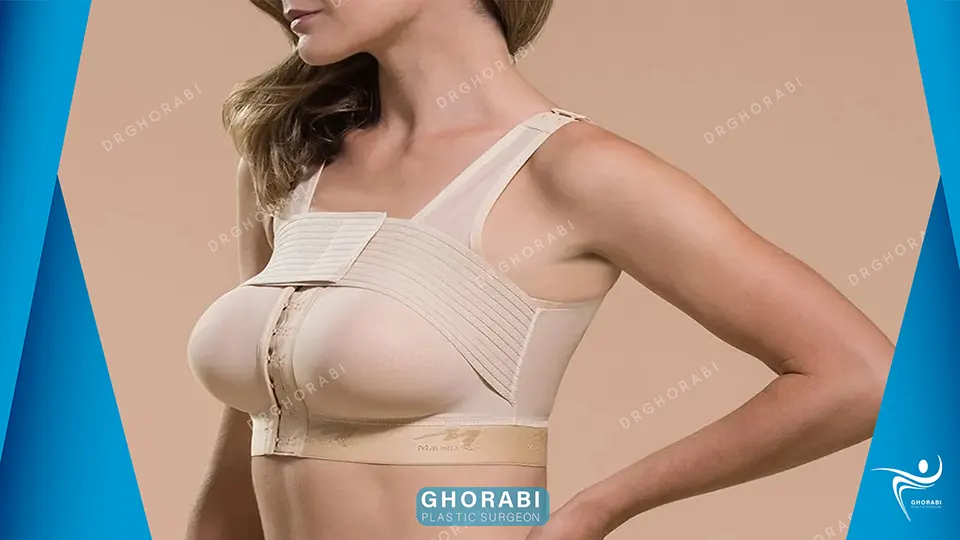
Breast implant surgery is performed under general anesthesia.
After surgery, the effects of anesthetics remain in the body for hours until they are broken down and excreted from the liver and kidneys. Therefore, it is recommended to accompany the patient at least during this period.
Some patients complain of pain at the prosthesis site within 24 to 72 hours after surgery. For this reason, analgesic and sedatives will be considered by the doctor.
Usually, during the first few days of surgery, there is inflammation and swelling of the breasts, which will disappear over time.
It is always recommended to use elastic bandages and special bras to reduce inflammation and protect the breasts.
Depending on the type of surgery, you can return to work a few days after the operation.
You will be able to walk and do your daily activities such as eating immediately after surgery and anesthesia recovery.
48 hours after the surgery, it is completely safe to take a bath, remove the dressing and wash the surgical site in the bathroom.
It is recommended to continue dressing the surgical site for a week after surgery and change it every 48 hours after bathing.
Since there is a possibility of bleeding, heavy physical activities such as lifting heavy objects or intense upper limb activity should be limited for two to four weeks. Sports such as athletics and aerobics are also prohibited during this period.
Sleeping on the breasts is prohibited for six to eight weeks.
During the recovery period, no pressure should be applied to the breasts and stitches.
Normally, the sutures are absorbable and do not need to be removed. In special cases, where non-absorbable sutures are used, the sutures are removed approximately ten to fourteen days after the surgery.
If needed, healing gels are prescribed for the scar area in the weeks after surgery
It is recommended to see a doctor during a schedule for examination
This table includes 48 hours after the operation, one week after the surgery, one month after the implant, three, six, one year after the prosthesis.
“In the following cases, notify your doctor as an emergency”
- Bleeding from the wound site that does not stop with the pressure of the dressing
- Increased swelling and bruising of the surgical site
- Increased redness at the surgical incision site
- Foul-smelling or yellow discharge from the wound
- Severe pain that does not decrease despite the use of prescribed painkillers
- Allergy to drugs or intolerance to drugs
- Fever and oral temperature above 38 degrees
- Feeling short of breath, severe chest pain, or an abnormal heartbeat
Things that you should follow after the breast prosthesis operation
Approximately 4 to 6 hours after the operation and the improvement of the condition, you can go home to rest and follow the following until complete recovery:
- Preferably avoid any kind of smoking for 1 month.
- Stay away from any kind of heavy and semi-heavy sports, even timed and fast walks for up to 1 month, and if any movement leads to pain in the chest area, avoid doing it.
- Take the antibiotics and medicines prescribed by the specialist until the treatment period is completed.
- During the first 2 weeks after surgery, rest or sleep on your back and avoid sleeping on your side, and avoid sleeping on your stomach for at least 6 to 8 weeks after surgery.
Time intervals of visiting a doctor after breast prosthesis surgery
The schedule for seeing a cosmetic surgeon includes:
- 48 hours after the operation
- One week after surgery
- One month after the implant
- Three months after surgery
- Six months after the first visit
- One year after the prosthesis
It is advisable for the client to refer for a check-up in the following years based on her age, medical record and the recommendation of the attending physician.
The best time to change breast prosthesis
One of the common questions of clients is when is the right time to change the prosthesis?
Who can undergo breast prosthesis surgery?
- Women between the ages of 18 and 60, who want to make their breasts more beautiful, implanting a prosthesis is considered as a cosmetic breast surgery
- Young ladies who do not have symmetrical breasts or suffer from breast tissue growth abnormalities are good candidates for breast implants.
- People who lost all or part of their breast due to reasons such as accidents and cancer.
- Those who have had abnormal and asymmetrical breasts since birth.
- Girls who have only one breast due to birth defects.
- Women who have small breasts due to hormonal problems or excessive thinness.
- People whose breast tissue has weakened and shrunk due to diet, pregnancy, breastfeeding and aging.
- Transgender men who are looking for gender reassignment surgery also perform breast implant surgery according to their specific conditions.
What kind of prosthesis do I need?
By carefully reading the contents of this section, you will find the answer to your question to a large extent, and in a face-to-face meeting with a plastic surgery specialist, you will be able to consult more easily and reach the final decision
Difference between teardrop and round prosthesis
- To explain, the round breast prosthesis is round in shape and gives volume to the upper part of the breast and the lower part of the breast in the same proportion.
- Round implants also have more gaps and lifts than teardrop implants.
- In comparison, teardrop implants create less volume in the upper part of the breast than in the lower part.
- Tear drop prostheses are designed to look more natural.
- However, there is a possibility of their rotation after surgery, and this can slightly change the appearance of the breast
- Round prostheses are better positioned and provide a similar result without the possibility of rotation.
- During the consultation session, talk to your surgeon about the shape and form of the prosthesis you want.
The difference between saline and silicone prostheses

- Saline breast implants are silicone shells filled with sterile saline. Implants may be pre-filled or filled with physiologic serum after the shell is inserted into the body. This type of implant gives uniform shape and strength to the patient. Implants are approved for patients 18 years and older.
- Silicone prosthesis has the same silicone layer, but inside it is filled with viscous silicone gel.
- Silicone implants look more like natural breast tissue and are the preferred material for many patients.
- For any reason, if the saline breast prosthesis is damaged, within a few days, the leaking physiologic serum will be absorbed by the body tissue and the signs of rupture will appear clearly.
- On the other hand, if a silicone prosthesis leaks or tears, it is difficult to detect by a person, and it is necessary to see a doctor and complete a diagnostic examination by ultrasound or MRI.
Possible risks and dangers of breast prosthesis
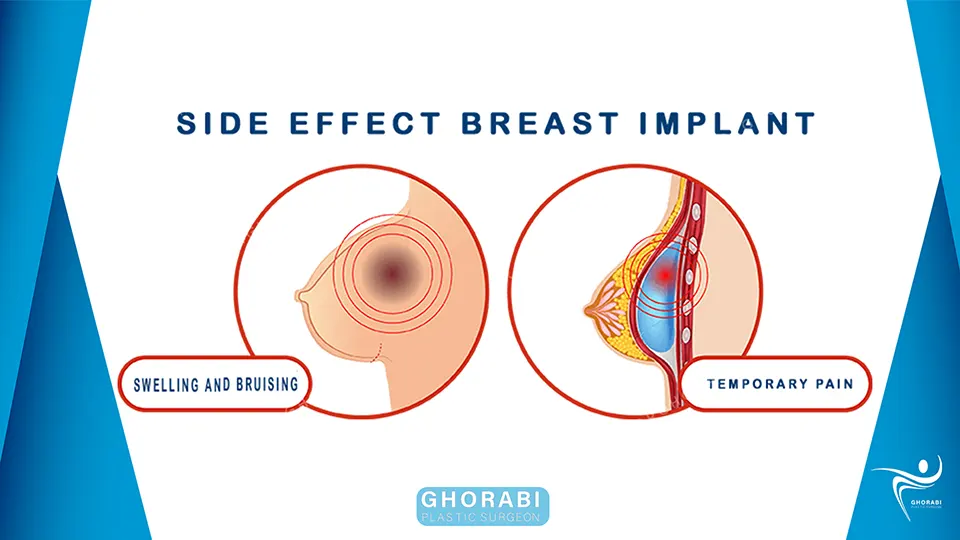
Breast prosthesis surgery is in the category of low-risk surgeries, if it is performed by a plastic and cosmetic surgeon, its side effects will be as minimal as possible.
Possible side effects of breast implants and prostheses include the following
- Complications of general anesthesia
- Bleeding and accumulation of blood in the pocket of the prosthesis (hematoma)
- Premature accumulation of light-colored liquid or in other words seroma around the prosthesis
- Infection, the main cause of which is bacterial contamination of the operating room environment, medical equipment, the surface of the prosthesis during its operation, contamination of the patient’s body surface.
- Unacceptable appearance of the surgical incision site
- Delay in the healing of the surgical incision site
- Continuous chest pain
- Changes in breast and nipple sensation temporarily
- Wrinkle of the surface of the prosthesis after operation, which is caused by the lack of sufficient skill of the surgeon in creating a suitable cavity for the prosthesis and the error in choosing the right size of the prosthesis according to the anatomy of the person.
- Leakage or rupture of the prosthesis wall
- Breast asymmetry
- Moving prostheses in different directions
- Excessive proximity of the right and left breast prosthesis to each other due to the lack of sufficient experience of the surgeon in creating a suitable implant envelope
- Dissatisfaction of the person in terms of the beauty and result of the operation
- The possibility of needing to re-operate
- Nonscientific and unprincipled placement of the prosthesis in place
- Changing the shape of the prosthesis and the surrounding tissue (Capsular Contracture)
- The formation of a type of lymph cancer around the prosthetic tissue
It should be noted that some of the side effects of breast prosthesis surgery may necessitate explanation or removal of the prosthesis.
The silicone is used in the manufacture of implants is associated with immunological changes that can lead to connective tissue disorders.
Breast lymphoma is one of the side effects that occur as a result of breast prosthesis surgery. This complication is a type of mild lymph type cancer and its prevalence rate is rare. Because the rate of its prevalence is very low, there is no ban on breast implants by the American Food and Drug Administration.
If a person gets breast lymphoma as a result of breast prosthesis surgery, in the early stages, the breast prosthesis along with the capsule around it is removed, the cavity of the prosthesis is washed and disinfected and replaced with a new prosthesis.
Remember that choosing an experienced specialist can reduce all the mentioned complications to a very high extent.
Contraindications for implanting breast prosthesis
As with any surgery, there are times when you are not a good candidate for that surgery and should be avoided. The following patient are not suitable candidates for breast prosthesis surgery until their disease is fully recovered:- Autoimmune diseases such as lupus Systemic Lupus Erythematosus (SLE)
- Weak immune system, for example, people who are currently under immunosuppressive treatment
- Women with active infection in any part of their body.
- Women with existing breast cancer or pre-cancer who have not received adequate and appropriate treatment for that condition.
- Beauties who are currently pregnant or breastfeeding their child
- Tissue blood circulation disorder in the chest area
Is breast prosthesis an obstacle to pregnancy?
It is understandable that pregnant women or those who plan to become pregnant in the future are concerned about the possible effects of breast implants on their bodies and the health of their unborn child. The ability of silicon to cross the placental barrier depends on factors such as the size of the silicon molecule and the concentration gradient of silicon in maternal and fetal circulation. Related studies on breast implants and pregnancy have found no evidence of toxic effects of silicone during or after pregnancy. Breast implants do not affect pregnancyIs breast prosthesis an obstacle to pregnancy?
It is understandable that pregnant women or those who plan to become pregnant in the future are concerned about the possible effects of breast implants on their bodies and the health of their unborn child. The ability of silicon to cross the placental barrier depends on factors such as the size of the silicon molecule and the concentration gradient of silicon in maternal and fetal circulation. Related studies on breast implants and pregnancy have found no evidence of toxic effects of silicone during or after pregnancy. Breast implants do not affect pregnancyDoes breast implants lead to breast cancer?
It is one of the most common questions among beauty seekers. There is a fact that in very rare cases, in people who undergo breast prosthesis surgery, a person gets breast ALCL. The symptom of this disease is unilateral or bilateral breast enlargement due to the accumulation of lymph fluid around the prosthesis. It is very easy to treat this condition by removing the prosthesis and its accompanying tissue and replacing it with a new prosthesisBreastfeeding after breast prosthesis surgery
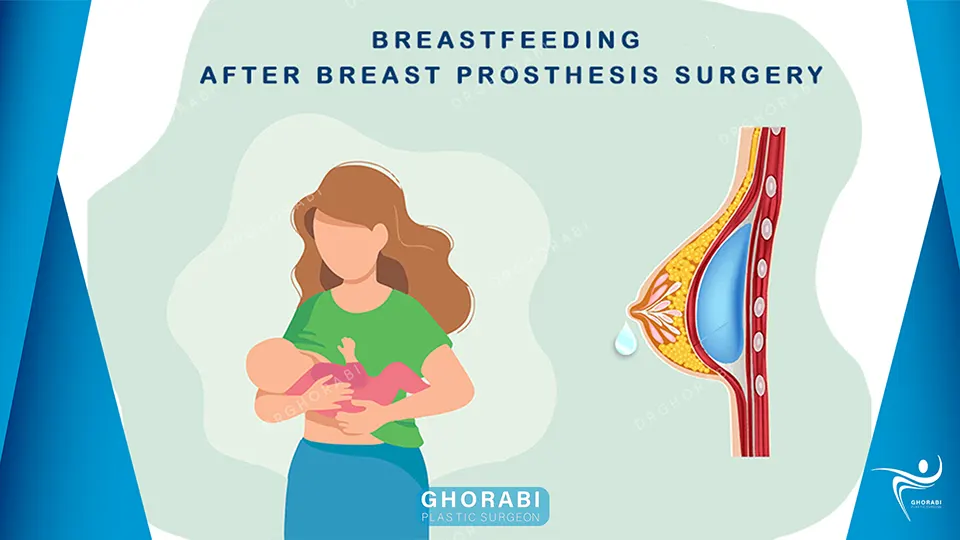
It is possible for you to breastfeed with a breast prosthesis, but this depends on other factors as well.
It depends on the size, location of the prosthesis and the type of surgery.
If the surgical incision is below the breast crease or under your armpit, you should have no problem breastfeeding.
But if the incision is around the areola, you may have problems because the milk ducts are likely to be cut.
Remember, there’s no real way to know until you try breastfeeding.
You may be able to produce some of the milk your baby needs and then supplement your infant’s nutrition with formula.
It’s a good idea to let your family doctor know that you have breast implants so they can monitor your baby’s weight and make sure you’re making enough milk and getting enough calories.
Cost of breast prosthesis surgery
Breast prosthesis surgery is more often performed in Tehran due to the higher experience of doctors, better facilities and easier access. Breast prosthesis surgery is considered a cosmetic procedure, and it will not be covered by insurance. In fact, the exact amount of this surgery is determined when the client is examined in person by a plastic surgeon, the necessary examinations are performed before the surgery, and the type of implant brand, the type of surgery center, the need for a breast lift at the same time as the prosthesis or the provision of other facilities are determined. Note that many factors are effective in increasing the cost of breast prosthesis and its surgery. Such as the type of prosthesis used, the doctor’s salary, the skill and experience of the plastic surgeon, the doctor’s expertise, the clinic’s facilities, the quality of the prosthesis, etc. are effective in determining the final price. Currently, the general tariff for breast prosthesis has been determined between 45 and 65 million Tomans based on the aforementioned cases in 1401Results obtained from breast prosthesis
If you are a suitable candidate for breast prosthesis surgery, it will help you to be more beautiful, increase the shape of your breasts and rejuvenate, and without a doubt, increase your self-confidence. This surgery, which is mainly performed to beautify and shape the breast, creates tangible and satisfactory results for the applicant. Of course, it should be kept in mind that the patient’s health is always a priority for a compassionate specialist. But in general, it can be said that this method will bring the shape of your breast to the level you are considering, and it also brings amazing results for people who are planning to have a prosthesis to restore their breast after breast cancer. Breast prosthesis is one of the surgeries that bring brilliant results to women who suffer from small breasts. Things like age or weight changes affect the shape and size of the breast. Remember, if you plan to lose or gain weight, it is advisable to postpone the surgery. If you do not want to use breast implants to enlarge your breasts, you can use other alternative methods such as fat injection into the breast.non-surgical method of breast enlargement
In 2003, the Thai government approved breast massage exercises as an alternative to breast augmentation with breast implants. The Thai government enrolled more than 20 women in publicly funded training courses to teach the technique. However, beyond Thailand, this technique has not been approved and popularized by the medical community. Despite the promising results of a six-month study on the therapeutic effectiveness of this technique, the research doctors advised the women participating in the study to gain weight to help enlarge their breastsIs breast prosthesis permanent?
*In the minds of many people, this question is raised whether the breast prosthesis is permanent? * How long after surgery does it need to be replaced? In response, it can be mentioned that most of the standard prostheses are permanent and will not need to be replaced, but for various reasons, during the time and changes in the breast tissue or the prosthesis, it may be necessary to replace the implant.Ten golden tips about breast implant
If you’re considering breast augmentation, it’s important to have a really good understanding of what to expect and be as prepared as possible before surgery.- Postpone surgery until you have considered all the physical, financial and psychological factors involved in this surgery, consult your surgeon after being completely sure.
- Your first breast procedure is unlikely to be your last, and may need to be changed after 10-20 years or more. You should think about the possibility of re-modification or removal of the prosthesis in later years. Are you prepared to have more surgeries in the coming years and bear the costs involved?
- You can try different breast sizes before surgery using a sizer or a 3D view, to give you an idea of the size you might like.
- You must be healthy to have breast implants. You should not have surgery if you have an active infection, currently have cancer, or are pregnant.
- The trend in recent years for breast implant surgery is to have a more discreet look and smaller implants instead of large ones.
- About half of women who have breast augmentation surgery experience a temporary change in nipple sensation, which can be painful for the first few weeks after breast augmentation surgery.
- What you see immediately after surgery is not the final result. At first, your new breasts will probably look unnaturally large, but over the next few months, you will achieve a realistic shape.
- Performing a teardrop prosthesis is sometimes associated with rotation and displacement, and remember that this type of implant mimics the natural shape of the breast, and you have more fullness in the lower half of the implant.
- Mammography (breast x-ray) is less effective in breast cancer screening in women who have breast implants. Because the X-ray cannot see the breast tissue behind it properly through the implant. It is important to inform the radiologist if you have an implant in the follow-up examinations so that he can use a special technique for optimal cancer diagnosis.
- For about a year after surgery, you should be careful when sunbathing. It is advisable to keep incision scars away from direct sunlight because the skin pigmentation that occurs will be permanent.

